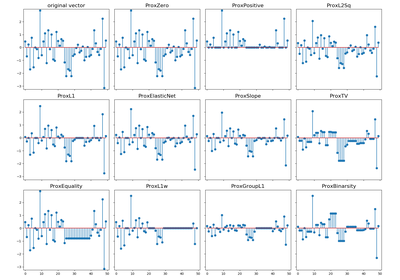tick.prox.ProxGroupL1¶
-
class
tick.prox.ProxGroupL1(strength: float, blocks_start, blocks_length, range: tuple = None, positive: bool = False)[source]¶ Proximal operator of group-L1, a.k.a group-Lasso. It applies
ProxL2in each group, or block. Blocks (non-overlapping) are specified by theblocks_startandblocks_lengthparameters.- Parameters
strength :
floatblocks_start :
listornumpy.array, shape=(n_blocks,)First entry of each block
blocks_length :
listornumpy.array, shape=(n_blocks,)Size of each block
range :
tupleof twoint, default=`None`Range on which the prox is applied. If
Nonethen the prox is applied on the whole vectorpositive :
bool, default=`False`If True, apply the penalization together with a projection onto the set of vectors with non-negative entries
- Attributes
n_blocks :
intNumber of blocks
dtype :
{'float64', 'float32'}Type of the arrays used.
-
__init__(strength: float, blocks_start, blocks_length, range: tuple = None, positive: bool = False)[source]¶ Initialize self. See help(type(self)) for accurate signature.
-
call(coeffs, step=1.0, out=None)¶ Apply proximal operator on a vector. It computes:
\[argmin_x \big( f(x) + \frac{1}{2} \|x - v\|_2^2 \big)\]- Parameters
coeffs :
numpy.ndarray, shape=(n_coeffs,)Input vector on which is applied the proximal operator
step :
floatornp.array, default=1.The amount of penalization is multiplied by this amount
If
float, the amount of penalization is multiplied by this amountIf
np.array, then each coordinate of coeffs (within the given range), receives an amount of penalization multiplied by t (available only for separable prox)
out :
numpy.ndarray, shape=(n_params,), default=NoneIf not
None, the output is stored in the givenout. Otherwise, a new vector is created.- Returns
output :
numpy.ndarray, shape=(n_coeffs,)Same object as out
Notes
stepmust have the same size ascoeffswhenever range isNone, or a size matching the one given by the range otherwise
-
value(coeffs: numpy.ndarray)¶ Returns the value of the penalization at
coeffs- Parameters
coeffs :
numpy.array, shape=(n_coeffs,)The value of the penalization is computed at this point
- Returns
output :
floatValue of the penalization at
coeffs
